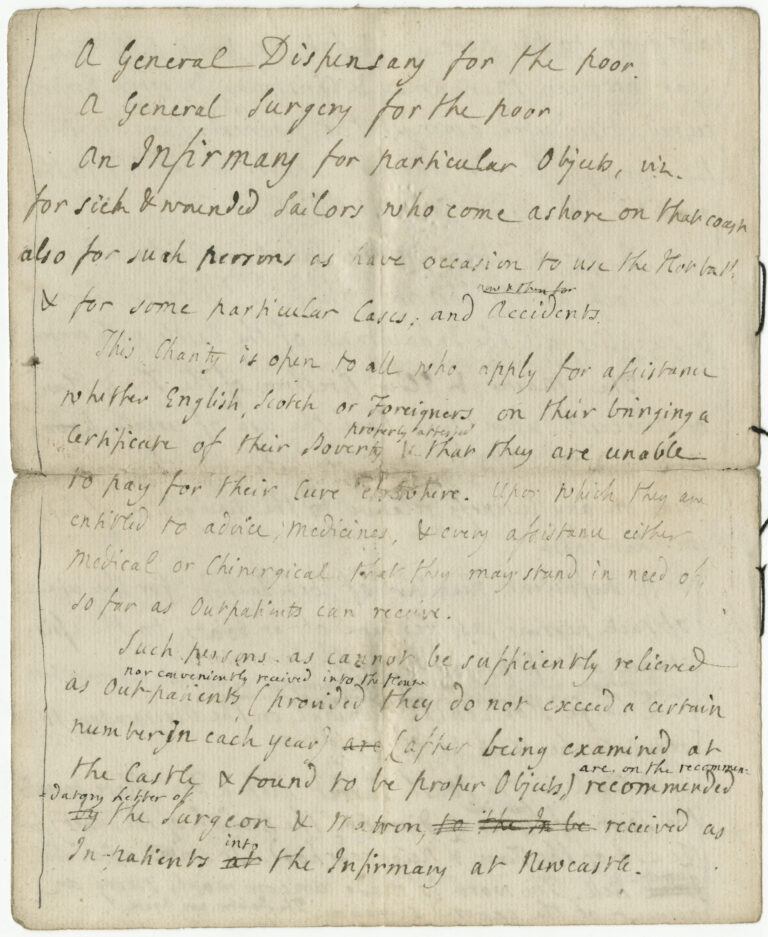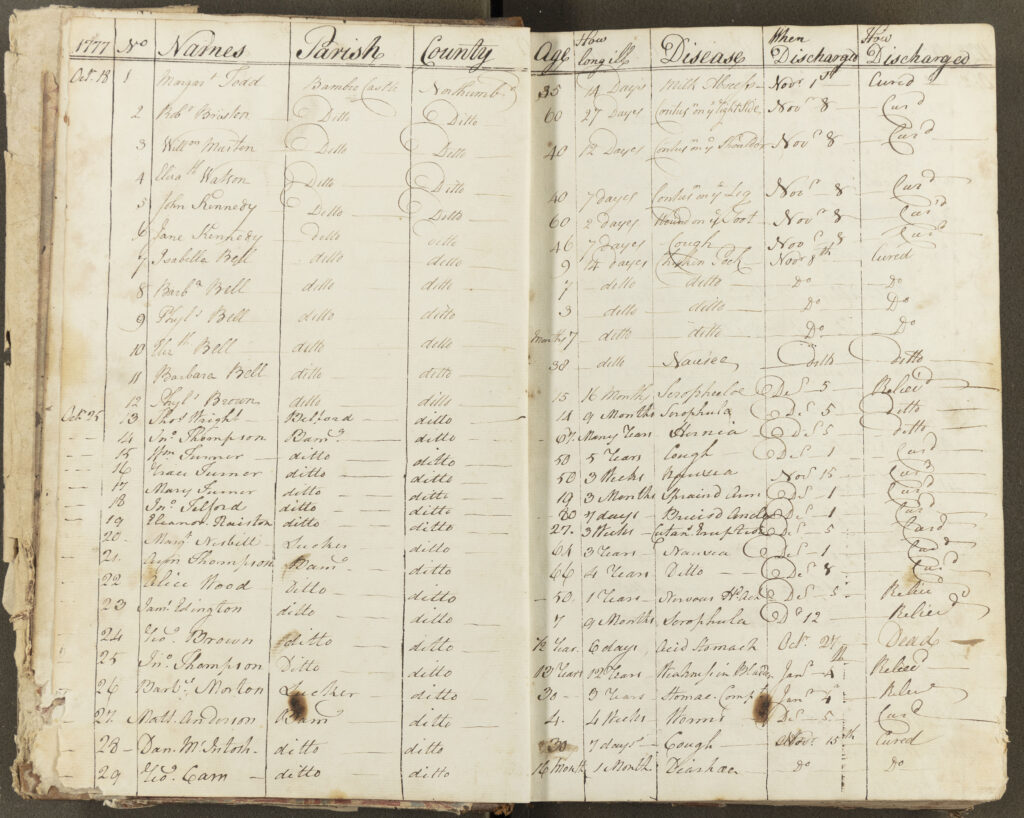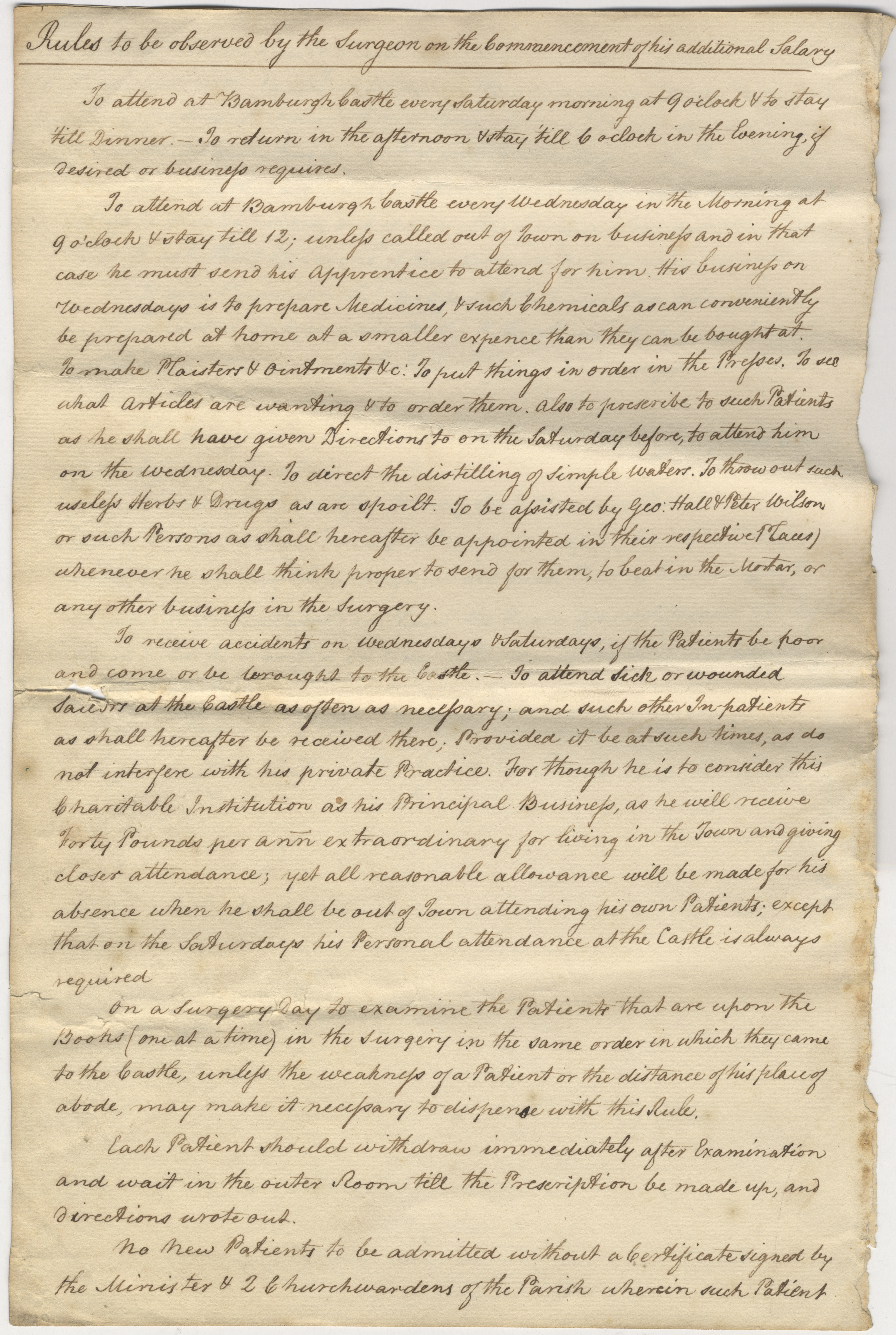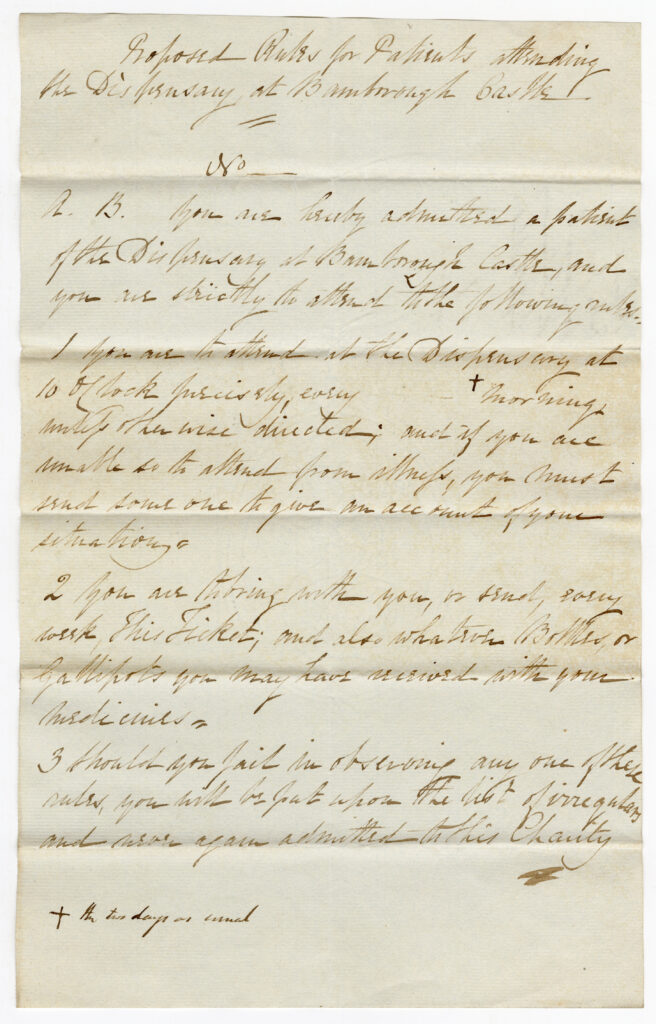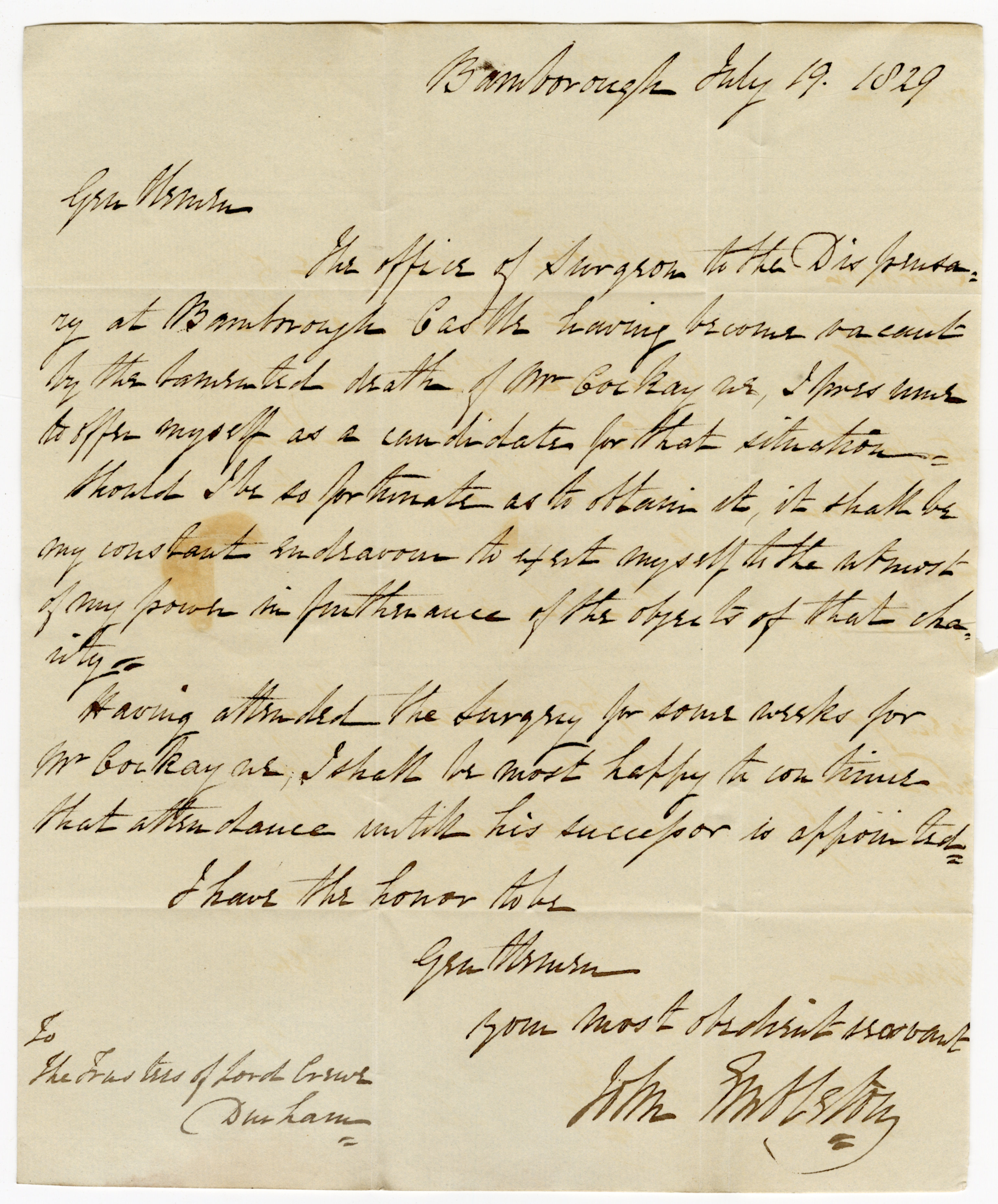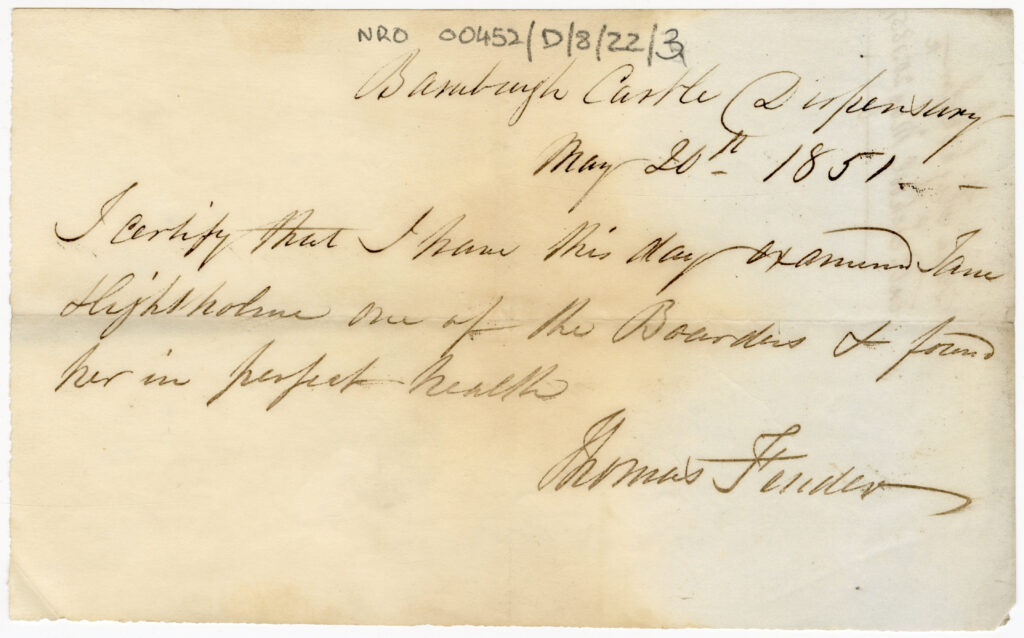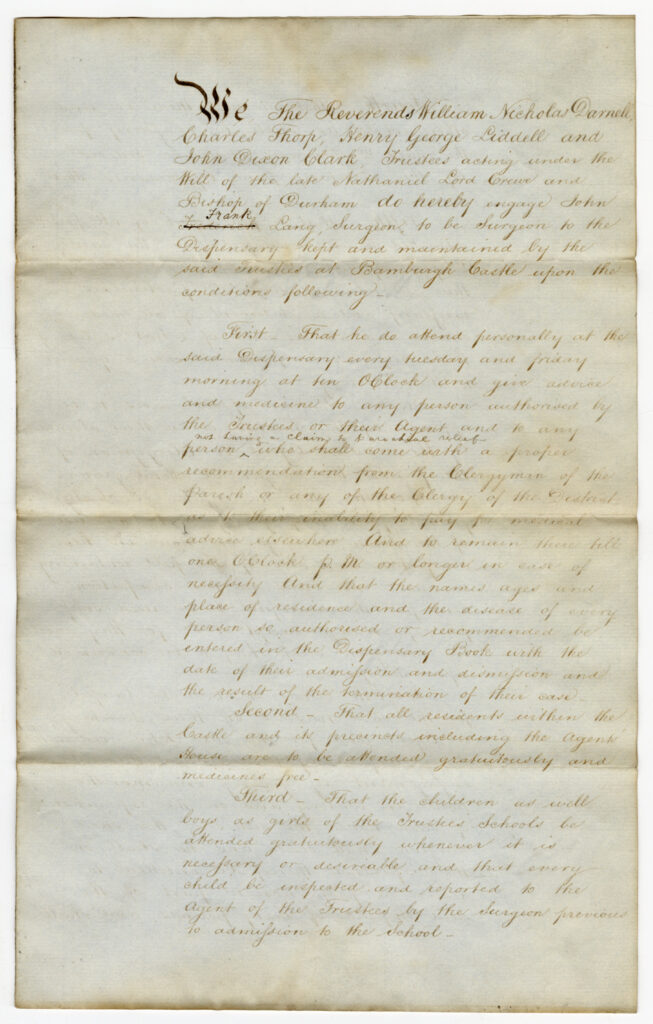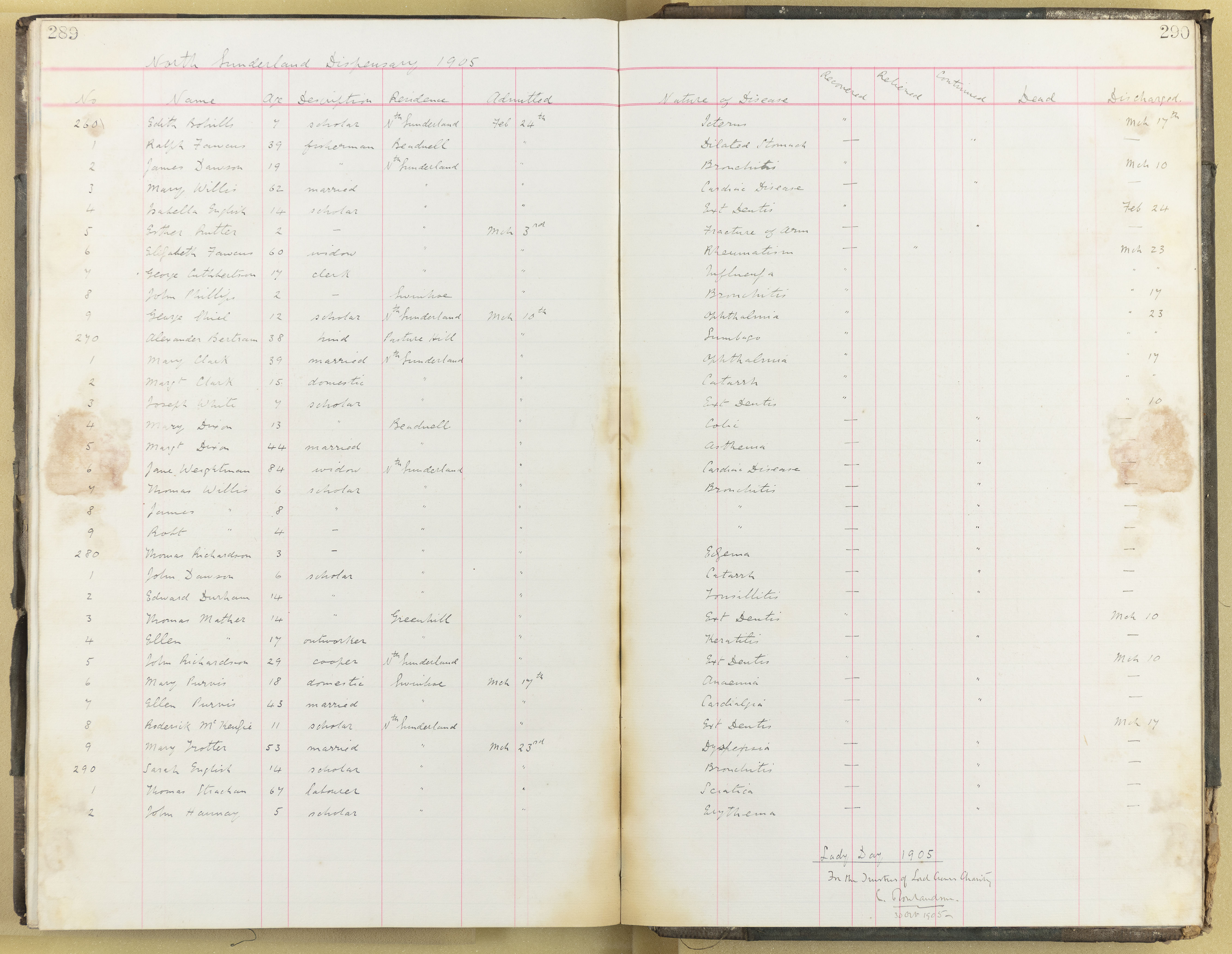INFIRMARY & DISPENSARY
CONTEXT
Noting the distance of 50 miles from Bamburgh to Newcastle Infirmary, an even greater distance to Edinburgh Infirmary, and the inability of the poor in the neighbourhood to pay for either a surgeon or drugs, the Trustees of the Lord Crewe’s Charity agreed on 20th August 1772 that an infirmary and dispensary would be set up at Bamburgh Castle (NRO 00452/J/36 p99).
The infirmary operated with a small staff of three. A physician and surgeon was employed to initially attend the infirmary for three hours every Saturday morning from 9am until 12 noon in one of the lower rooms of the castle, and was to be paid half a guinea each time. The equivalent of about £57 in 2023 (Bank of England – Inflation Calculator). The infirmary was set up as an outpatient clinic, with the surgeon available to give advice; administer medicine; treat common ailments such as dressing sores; and, on the production of a certificate attesting to the assessed poverty of the patient, perform operations.
Mrs Raston, who lived in the castle, was paid half a crown per week (about £13.60 in 2013) to make up medicines, take care of the drugs, keep the books, clean, and otherwise keep the surgery in order. John Robson was taken on to assist the surgeon, beat the mortar and undertake the ‘more laborious work’. He was paid 18 pence per week for the position (about £7.50 in 2023).
By late October 1772, after only 2 months of operation, patient demand had increased to the extent that the surgeon was unable to see and treat all of the patients within the allotted 3 hours. The surgeon was instructed to attend for the whole day on Saturdays, along with the possibility of part of the day on Friday or Sunday. His earnings were raised to 15 shillings to compensate for the increased demand, along with being provided bed and board on the Friday and Saturday nights.
Aware of medical developments in London, and through consultation with his brother, the surgeon William Sharp, Dr John Sharp wanted the infirmary at Bamburgh to be a ‘modern’ institution. Individual rooms within the castle were allocated to different uses for the infirmary. This included a room for shipwreck survivors; a surgery; a dispensary; and drug storage.
The surgeon was well equipped with the latest range of medical tools. Dr Sharp painstakingly noted all of the equipment in his accounts. This included medical staples such as 16 lancets, several pewter syringes, a spring penknife, a work tub, apothecaries measures and instruments brought from London, an oilskin apron for the bathroom, bellows for giving artificial respiration to ‘drown’d persons’, along with the unusual ‘electrifying machine’ as recorded in an inventory of the contents of Bamburgh Castle dated 16-18 July 1792. They also operated hot- and cold- seawater baths, used alongside a sedan chair, given by William Sharp, to transport invalid patients. By 1786, the infirmary offered free inoculation against smallpox. During the 19th century, prescriptions for wine were frequent and generous, but later dispensing was more sober.
In its first year, the infirmary treated 206 patients. This had tripled by 1775, and in the following year this had increased to 1,009. During the 1780s, the infirmary saw a sustained period of high patient numbers, on occasion exceeding admissions of 2,000 patients annually.
There was no defined catchment area for patients. In his account, Dr John Sharp noted that all could apply for treatment ‘whether English, Scotch or Foreigners on bringing their certificate of their poverty properly attested’ (NRO 00452/D/5/2/1/1/65). Patients were required to bring a certificate signed by a clergyman stating that they were eligible for treatment under their impoverished status. The charity provided patients with blank certificates onto which the signatures could be obtained.
Dispensary case books record the ‘nature of disease’ patients presented with. This included common conditions such as coughs, colds, sciatica, anaemia, and reflux, along with bone breakages, injuries, and infections. Those too infirm to attend the castle, along with expectant mothers, were visited in their homes.
After a two-decade period of increase from the infirmary’s conception in 1772, the establishment saw a slow decline following the death of Dr John Sharp in 1792. Despite dwindling patient numbers, a government inspection during the 1860s, and agricultural depression It is worth noting that the operation continued on some scale for a further two centuries with the last payments for medicines being purchased by Lord Crewe’s Charity in 1958.
DOCUMENTS
This sample page from the register of patients at Bamburgh Castle Dispensary provides an interesting overview of some of the cases treated at the Dispensary in 1777. The register lists names and ages of patients, their parish – it is not clear whether this is the place that they lived or their place of settlement, the period of duration of their illness, disease, date of discharged and the circumstances under which they were discharged. The list includes three children under 2 years, four children under 10 years, four teenagers and five patients aged 60 or over. The oldest patient is John Telford aged 80 who is suffering from a bruised ankle. Three of the patients under 2 years – Phyllis Brown, Thomas Wright and James Edington – suffer from scrophula [scrofula]. This is a bacterial disease that causes swelling and lesions in the neck. All of the patients live in Bamburgh and environs. The dispensary and surgery had a wide catchment area with the nearest infirmaries to provide medical care being at Edinburgh and Newcastle.
The document sets out the rules to be observed by the surgeon at Bamburgh Castle Infirmary in 1783. The document is signed by William Co[c]kayne, surgeon in 1783 and John Embleton, surgeon in 1829. The rules can be summarised as follows:
- The surgeon must attend the Bamburgh Castle Dispensary each Saturday from 9am until dinner. He must return in the afternoon and say until 6pm or as required.
- He must attend the Dispensary each Wednesday until 9am until noon unless called away on business. If called away he must send his apprentice to attend. Wednesday must be spent preparing medicines and making plaisters (plasters) and ointments, ordering items in presses (cupboards), ordering items, prescribing for patients, distilling simple water (likely to be boiling of seawater to produce pure water), and disposing of spoilt ingredients for medicines.
- He should deal with cases of accidents each Wednesday and Saturday and to attend to sick or wounded sailors at the Castle as required “provided that it does not interfere with his private Practice”. The surgeon is allowed to earn a further £40 per year from the latter.
- Each surgery day to deal with patients one at a time in the order that they arrive unless there are particular reasons – state of health of distance travelled from their home – that this should not be the case.
- New patients cannot be admitted without a certificate provided by the clergyman and two churchwardens of their parish. If the patient is a “Dissenter” (not a member of the Church of England) the certificate to be signed by the minister of their congregation and two Elders.
- The Dispensary is open to all patients with the exception of those with a putrid fever (typhus) or other infectious diseases.
- Surgeon is expected to keep record of patients admitted in the Admission Book.
- Surgeon is expected to keep record of prescriptions issued in the Prescription Book.
- If required, patients are to be issued with “directions” in writing and a printed Bill of Diet.
- Appropriate surgery to be offered to in-patients and out-patients.
- Surgeon to instruct the Matron, Assistants and journeyman (apprentice) in making up prescriptions.
- Where patients are unable to receive necessary treatment as out-patients they are to be recommended as an in-patient to Newcastle Infirmary via a letter of recommendation from the surgeon. The document sets out a procedure around this.
- The Dispensary will offer free inoculations to children. (This was inoculation against smallpox and is an example of how advanced the Dispensary was).
- Regarding ‘chirurgical’ (surgical) cases, the surgeon has the right to make autonomous decisions. If other surgeons are present he should ask their opinion but has the right to make his own judgement.
- If a physician is present on a surgery day, (the Charity engaged a surgeon, physician and two Assistants in the 18th century), he should be asked to prescribe for a patient in some instances.
- The surgeon can be dismissed by agreement of three of more Trustees.
- The surgeon can attend to any sick person living in Bamburgh Castle without charge.
This letter was written by William Cockayne, surgeon, to Dr. John Sharp. William Cockayne served as surgeon at Bamburgh Castle for almost 30 years. It is likely that Cockayne was recruited in London, by William Sharp, brother of Dr. John Sharp. William Sharp was resident surgeon at St. Bartholomew’s Hospital in London. After enquiring about Dr. Sharp’s health, William Cockayne apologises for his absence from the Dispensary on the previous Saturday reporting that he was unable to attend due to heavy snow at Wooler and he could not travel more than two miles, and was hurt by his horse stumbling in deep drift. The weather has caused a number of deaths locally and at sea around the coast at Bamburgh. The letter references another of the Lord Crewe charities – a charity to provide support for individuals shipwrecked off the coast at Bamburgh. “There has been a Great Number of poor distress[e]d seamen reliev[e]d, whose Prayers and thanks are offer’d up for Your Welfare’. Mr. Cockayne goes on to give a short report on the business of the Dispensary. Business is “much as usual” with attendances at between sixty and one hundred. Reference is made to a particular case, the of “Henry’s child” who has an enlarged head.
This document is a draft set of rules for patients attending the dispensary at Bamburgh Castle. The document is undated but thought to have been compiled around 1800. The rules reads:
- You are to attend at the Dispensary at 10 o’clock precisely every [blank] morning unless otherwise directed and if you are unable so to attend from illness, you must send some one to give an account of your situation.
- You are to bring with you, as usual, every week, This Ticket, and also whatever Bottles, or Gallipots you may have received with your medicine.
- Should you fail in observing any of these rules, you will be put upon the list of irregulars and never again admitted to this Charity.
A gallipot is an earthenware pot used to dispense medicines.
This document is one of a large series of petitions or applications received by the Lord Crewe Trustees. John Embleton writes that he is aware that a vacancy has arisen for the post of surgeon following the death of Mr. Cockayne. John writes that if successful it shall be his “constant endeavour to exert myself to the utmost of my person in furtherance of the objects of that charity”. We learn that John Embleton has experience of working at the Dispensary having worked there for some weeks for Mr. Cockayne. John’s application was successful, and he was appointed surgeon in 1829.
One of the functions of the surgeon was to examine prospective pupils of the Bamburgh Castle boys and girls schools prior to admission. This paper signed by Thomas Fender certifies that Jane Slightholme, one of the school boarders is in “perfect health”.
This document is a signed contract of engagement of John Frank Lang as surgeon at Bamburgh Castle Dispensary dated 4 May 1850. The document provides information about the operation of the Dispensary.
- The surgeon is expected to attend the Dispensary two morning per week – Tuesday and Friday at 10am. He is expected to administer to advice and medication to any patient attending with a ticket – see the draft rules of the Dispensary (NRO 00452/C/3/4/8/33) – and to any patient attending the Dispensary who is not in receipt of poor relief and has a recommendation from a clergymen stating that the patient is unable to pay for medical advice. The surgeon must remain at the Dispensary on the aforementioned days until 1pm or longer if required. The surgeon must maintain a record of patients attending in the Dispensary Book.
- That all residents of Bamburgh Castle including the Agent are to receive free treatment at the Dispensary.
- That the children attending the Bamburgh Castle Schools should also receive free treatment at the Dispensary and that all children should be “inspected” prior to admission to the Schools.
- That all medicines required by the Dispensary should be ordered from Apothecaries Hall. [This is a reference to Apothecaries Hall, London. The Hall is situated in Black Friars Lane and was the home of the Worshipful Society of Apothecaries of London. Until 1922 the Society manufactured and sold medicines].
- That a quarterly report of admissions with details of treatment etc. should be made on a quarterly basis.
- That particular cases, approved by the Trustees of the Charity of their representatives, the surgeon may attend to cases gratis – this is likely to refer to cases that do not have the ticket referred to above.
- That the surgeon will receive an annual salary of £120 plus use of a rent-free house, garden and field. Hay may be grown on the field once in two years.
- The Trustees may terminate the contract of the surgeon after one month’s notice.
Bamburgh Castle was sold by the Lord Crewe Trustees to Lord Armstrong in 1894. The Lord Crewe Trustees continued to support a dispensary at North Sunderland. This sample page from the North Sunderland Dispensary case book of 1905 lists some of the patients treated in that year. The register lists names and ages of patients, occupations/marital status, residence, date of admission, disease and outcome. Patients’ residences are in the area immediately around North Sunderland – medical care was widely available at this point and a wide catchment area would not be expected. The youngest patient is 2–year–old John Phillips of Swinhoe who suffers from bronchitis. The oldest patient is 84-year-old Jane Weightman, a widow of North Sunderland. Jane suffers from cardiac disease.
FURTHER READING
The Charities of Nathaniel, Lord Crewe and Dr John Sharp 1721-1976 by CJ Stranks published by the Dean and Chapter of Durham 1976.
Memoirs of Nathaniel, Lord Crewe edited by Rev. Andrew Clark printed for the Camden Society 1893.
The Good Sharps by Hester Grant, Penguin Random House 2020
Dilston Hall…A Visit ot Bamburgh Castle with an account of Lord Crewe’s charties etc by WS Gibson published by Longman, Brown, Green and Longmans 1850
Dorothy and the Forsters of Bamburgh by John Bird, published by John Bird 1982
Bamburgh Belford Warenmouth Spindleston Outchester by Frank Graham published by Frank Graham 1976
Lord Crewe’s Charity website: https://www.lordcrewescharity.org.uk/
Northumberland Archives exhibition on Lord Crewe’s Charity: https://northumberlandarchives.com/exhibitions/crewe/1.html
Bamburgh Research Project website: https://bamburghresearchproject.wordpress.com/
Northumberland Archives blog on the electrifying machine: https://northumberlandarchives.com/test/2020/05/05/the-electrifying-machine-bamburgh-castle/
BBC Free Thinking feature on Bamburgh Castle surgery: https://dralun.wordpress.com/2015/11/02/bbc-free-thinking-feature-bamburgh-castle-surgery-c-1770-1800/
Article on overcrowded and underfunded 18th century hospitals: https://dralun.wordpress.com/2014/10/06/overcrowded-and-underfunded-18th-century-hospitals-and-the-nhs-crisis/
Article on 18th century medical jobs at Bamburgh Castle: https://dralun.wordpress.com/2014/01/22/do-you-need-a-doctor-applying-for-medical-jobs-in-the-eighteenth-century/
Article on 18th century medical job wages at Bamburgh Castle: https://dralun.wordpress.com/2014/01/24/negotiating-a-pay-rise-18th-century-style/
History Today article on Bamburgh Castle infirmary and dispensary: https://www.historytoday.com/hidden-hospital-bamburgh-castle-infirmary-and-dispensary
Article on Dr John Sharp: https://www.philanthropynortheast.com/the-philanthropists/sharp-dr-john
Bamburgh Bones website: https://bamburghbones.org/


